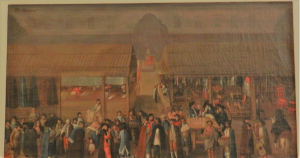
Any historian who has walked from the metro San Lazaro to the Archivo General de la Nación in Mexico City is familiar with the smells and sounds of the “ambulantes,” or street stalls, that encircled the station. Encircled, past tense, because on April 4th, I walked out of the station, past lines of shield-baring police, to find that the city had cleared away every single stall and put up a high, metal wall in their place.
The city’s secretario del gobierno issued a statement on Twitter describing the change as a move to “reclaim public space” and to “better public transportation services.” They also listed sanitation, public safety, and illegitimate commerce as reasons for dismantling the stalls.
Unsurprisingly, the stall-owners are angry. Those vendors have been there since at least summer of 2014, my first visit to CDMX, though I assume they’ve been there much longer. It is unclear whether they will be relocated or reimbursed in any way, but even if they were to be relocated, it would be difficult to find a place that replicated the kind of sales they made by their proximity to the metro’s foot traffic.
This episode echoes my own research on commercial justice in colonial Mexico City. The struggle between the state and informal commerce has been going on since at least the early 17th century, and probably longer. In 1608, for example, royal officials demanded that all vendors that did not have explicit license to sell in the Plaza Mayor of the city should dismantle their stalls. The official complained that “many people are inclined to hang about there rather than turn to other ministries more important and necessary to the Republic.” Much later in that century, a huge fire caused by rioting masses gave officials the opportunity they’d been looking for to go after the vendors whose stalls formed the Baratillo, or the black market center of the massive Plaza Mayor market. Like the secretario, colonial officials also argued that the Baratillo formed a public health and safety concern and infringed on the rights of legitimate traders.
And so they did, in some ways. The black market traders set prices lower than their legitimate competitors, undercutting their business. As a colleague reminded me, these stories aren’t simply about the state oppressing the people. In San Lazaro, the legitimate business owners, and even many of the metro riders, may be happy to see the informal market go, though consumers perhaps less so. In the residential, upper-middle class neighborhood of Coyoacán, the local business owners and residents have put up signs warning that ambulantes are an affront to the historical character of Coyoacán. From my research, it’s clear that they’re misremembering their own history as street stalls and vendors have formed part of the fabric of Mexico City since the colonial period. Then, as now, the government argues that it seeks to balance competing interests for the common good, though whose interests matter the most is often dictated by class, race, and gender. In pursuing the common good, it’s often the most vulnerable and economically marginalized that must make way and move over.